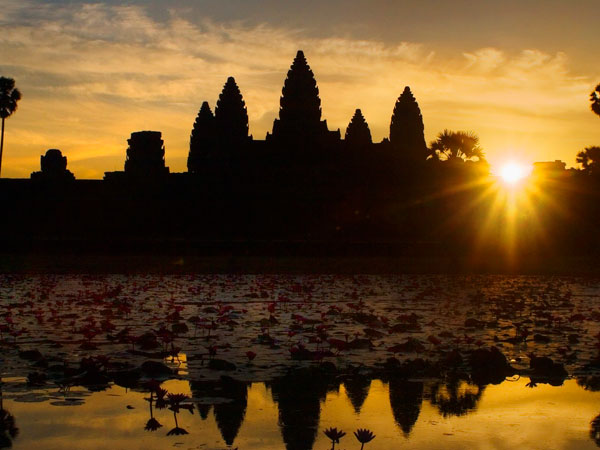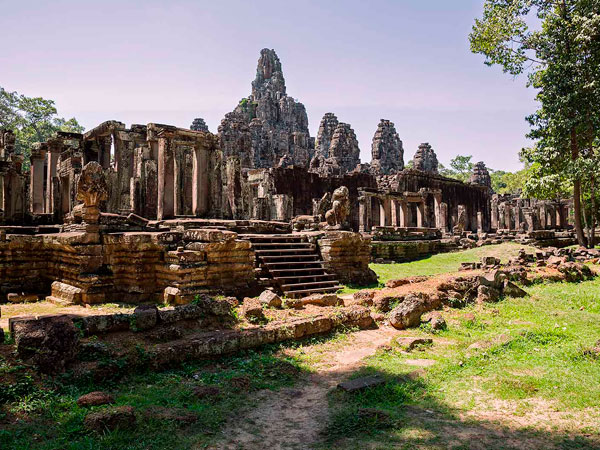Tonle Sap Lake is the largest freshwater lake in Southeast Asia and is the second most popular attraction in Siem Reap, after Angkor Wat. Also called Boeung Tonle Sap, it hosts one of the world’s most vibrant ecosystems, with massive numbers of many different species of wildlife in and around the lake, which helped to sustain and grow the ancient Khmer civilisation and continues to supply Siem Reap restaurants. It is also famous for its fascinating local communities and their floating villages.
The massive lake is as much as 250 km in length and 100 km across at its widest point, making it seem like an inland ocean because it is impossible to see the opposite shore from ground level. Surprisingly, it is actually fairly shallow, with a maximum depth of only 10 metres, but the sheer size of it means that it can hold up to 80 km3 of water.
Tonle Sap Floating Villages
There are actually several so-called floating villages located on and around the Tonle Sap Lake and they are all somewhat different. Naturally, most of the villages depend on the lake for the natural resources it provides, in terms of fishing and wetlands.
While you can try a ‘do-it-yourself’ tour, it can be a hassle and there are stories of people having problems trying to do it themselves. We therefore strongly recommend you book a tour to the area, most of which include roundtrip transport, lunch and plenty of opportunities to interact with the local residents. The four main floating villages are listed below.
Chong Khneas
The Tonle Sap Lake floating village nearest to Siem Reap, it is the one most visited by tourists. In the wet season, it really is a floating village, with houses, shops, schools, etc. all bobbing on the water. Even though it is somewhat ‘touristy’, it is still interesting and worth seeing. Tours usually include stopping at a souvenir and snack shop, and a visit to the Gecko Environment Center.
Kampong Phluk
This is not actually a floating village as the houses are built on tall stilts. In the dry season, the village is high and dry, with the tall stilted houses lining the road. When the water level is high, the stilts are submerged, and the houses seem to ‘float’. This is also the place where you can take boat rides through the flooded forest. It is visited by relatively few tourists. Home-stay is available.
Kampong Khleang
Being far from Siem Reap, it takes about two hours by boat from the Phnom Krom boat landing to reach here. There is an outer floating village and an inner stilted village. Kampong Khleang has the largest population of all the villages on Tonle Sap Lake and its remote location means that it is visited by fairly few tourists.
Prek Toal
A somewhat smaller floating village, it is the starting point for bird watching tours to the Prek Toal core area of the Tonle Sap Biosphere Reserve (see Bird Watching). This is an important habitat for many endangered bird species. There is a biosphere information centre and a water hyacinth weaving centre. Overnight stay is possible, but is not well organised and may not be suitable for all visitors.
The Best Time to See Tonle Sap Lake
During the dry season, the Tonle Sap Lake drains into the Tonle Sap River, which flows into the Mekong River. The lake becomes very shallow and large boats sit on the bottom. During this time, villages on stilts are left high and dry, and floating villages move further out onto the middle of the lake. The surrounding forests dry up and some bird sanctuaries cannot be reached.
However, in the rainy season (June to October), the huge amount of water in the Mekong causes the Tonlé Sap River to reverse its flow which, combined with with the extra water coming from upstream, means that the lake grows to five times its size in the dry season. The surrounding plains and forests flood, creating an incredibly diverse and rich ecosystem, and the floating villages are at their best and most accessible. Trips to the bird sanctuaries are best from December to April.








